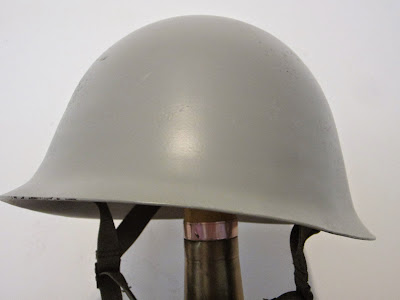Is it bad that I still say Red China?
Old habits die hard, I guess.

Eschewing the trappings of centuries of colonial or outside influence, the Peoples Republic was happy to discard the Soviet Ssh40 steel helmet which characterized its participation during the Korean War (and other hot spots of the Cold War), for their very own, motherland-produced steel GK 80/A. This light gray model is worn by sailors of the People's Liberation Navy.
This Chinese manufactured helmet is simple, strong, asymmetrical, and ironically very similar the the M30-32 helmet of the Japanese forces that occupied China during WWII.
The shell is simple and straightforward, with a slight upward tilt to the raw rim running forward ending in a very modest visor. With good depth to the shell,
you can protect a lot of head with this helmet.
The profile of the rear skirt really brings to mind that Japanese number from the dark days.
From the top this helmet has a distinct ovoid shape, narrowing at the front.
The liner is the tried-and-true Riddell system pioneered in the US M1 helmet and copied by numerous nations.
The four chinstrap bails are affixed to the shell by four spot-welded hooks.
Using mostly cotton web, the suspension is very similar to the American M1 of WWII days. The band is a strip of vinyl backed with a soft rubber shock absorber. The space between the shell and the wearer's head is about three quarters of an inch, again similar to the American M1.
Adjustment is easy with a buckle in the rear...
and a tie at the top, an obvious copy of the M1 system,
embracing the foreign to further the revolution.
The Y-yoke chinstrap does not unfasten but is completely adjustable with a cam-style buckle.
A rudimentary chin-cup is sewn into the strap.
Unlike an earlier production PLA helmet profiled here, this model does not have"A" washers, instead it has eight of these unique studs connecting the suspension to the shell, and this reveals a weakness in this steel plain Jane.
Those eight studs communicate to the outside of the shell where they are machined flat, hard for the eye to detect (dimple at center of frame) but create weak points ballistically.
This is an unissued helmet that came in the original factory packaging. Representing the next-to-last generation of the PLA steel helmet, this example is a nice first stab by China at establishing a unique look for its forces.
Overheard exchange:
Red Guard: China is not imperialistic!
Gunboater: Want ta bet?



















































